May 25, 2025 | 07:44 GMT +7
May 25, 2025 | 07:44 GMT +7
Hotline: 0913.378.918
May 25, 2025 | 07:44 GMT +7
Hotline: 0913.378.918
Despite being busy with work, Mr. Nguyen Ton Xuan Sang, Director of Nhon Hai Tourism and Fisheries Service Cooperative in Quy Nhon city, Binh Dinh province, still attended the workshop on "Tasks and solutions to develop seaweed industry" organized by the Ministry of Agriculture and Rural Development in Phu Yen, to learn how to cultivate and deploy in his hometown.
According to Mr. Sang, the oceanic area in Nhon Hai Commune has great potentials for seaweed cultivation. Seaweed harvesting seasons in the past have given local farmers a substantial amount of profit. When the local government barred people from exploiting seaweed to protect the coral reefs, the locals started tinkering with Kappaphycus alvarezii, also known as the elkhorn sea moss from the early 2000s. People planted the elkhorn sea moss densely along the coast but the plan ultimately failed; consequently, Mr. Sang wants to learn the process of growing seaweed in order to pass it on to the locals.
“For 2023, we recommend that fishermen in the commune grow elkhorn sea moss in both shallow and deep waters to identify which are most suitable, then replicate the model to create livelihoods for the local. Our cooperative is producing seaweed beverage but the purchase of raw materials is too difficult, we can only buy more than 100kg of dried seaweed locally every year, the least we could by was around 50 to 60kg, most of which are naturally extracted seaweed. If the model is successful, we will replace raw seaweed with elkhorn sea moss to develop the cooperative's beverage production more sustainably. During the construction of a new rural area, we will register this product as the local OCOP product", Mr. Nguyen Ton Xuan Sang shared.
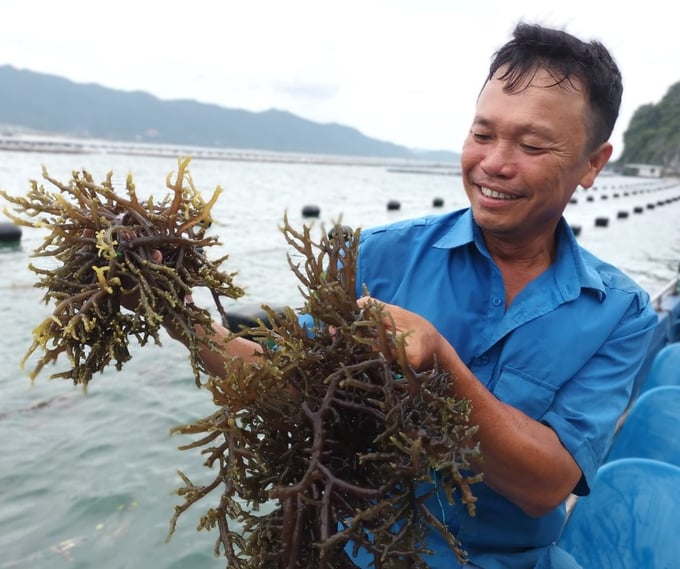
There have been many successful seaweed production models in Vietnam. Photo: HL.
Successful models of seaweed production in Vietnam have given great hope to people who are eager for seaweed such as Mr. Nguyen Ton Xuan Sang. Scientists at the Nha Trang Institute of Oceanography have imported grape seaweed from Japan for research and trial planting by utilizing nutrient reproduction in composite tanks and pond bottoms since 2002. Research shows that the grape seaweed can be grown in organic sludge-rich shrimp ponds.
In 2003, Ho Chi Minh City University of Agriculture and Forestry tested the planting of grape seaweed in a system of cement and composite tanks in Binh Thuan province. Results showed that grape seaweed can grow quickly under a closed process; namely, one batch of grape seaweed takes roughly 30 days before they are ready for harvest.
Phu Yen Agricultural Seed Center is coordinating with businesses to implement a program of elkhorn sea moss tissue culture. So far, around 500,000 seed tissues have been cut and nursed, and commercial elkhorn sea moss has been tested on an area of 5,000m2 in the open sea at the Aquaculture Seed Station of the Phu Yen Agricultural Seed Center. As a result, approximately 20,000 kg of fresh, high quality seaweed has been harvested after 4 months of cultivation.
According to the National Center for Agricultural Extension, integrated farming is a popular trend because it maximizes the efficiency of water usage. Under the Science and Technology Program for New Rural Development, the Ministry of Agriculture and Rural Development has assigned the National Center for Agricultural Extension as the manager to coordinate with the Aquaculture Research Institute III and the Agricultural Extension Centers of Khanh Hoa, Ninh Thuan, Thua Thien - Hue, Quang Binh to develop an integrated farming model that combines black tiger shrimp, snail, sea cucumber and seaweed in central coastal provinces. The model has since yielded generally positive results.
The National Agricultural Extension Center estimated that profit from the integrated farming model can reach 449.4 million VND/hectare/crop. Compared to the single farming model deployed by other households with the same farming area, the profit of single farming is estimated at only 259 million VND/hectare/crop.
According to research conducted by the Department of Agricultural Product Processing and Market Development under MARD, between 1965 and 2012: 3,129 natural products or bioactive molecules from seaweed were developed worldwide; 53% of which is extracted from red seaweed, 39% from brown seaweed and 8% from green seaweed.

The oceanic area of Nhon Hai commune, Quy Nhon city, Binh Dinh province has great potential for seaweed production. Photo: V.D.T.
The notable growth of the seaweed market lies in its application in the food industry, which is the driving force behind the seaweed trade. Seaweed extract is also increasingly used in pharmaceuticals, textiles, cosmetics, paper, biofuels, and feed additives. Most notably, dried seaweed was found to be effective in controlling and removing between 50 and 70% of methane in treatment for pollution from livestock waste. Seaweed consumption in Asia-Pacific accounted for 75% of the total commercial seaweed market in 2016 and has grown rapidly over the years.
Europe and North America have invested heavily into the seaweed industry, which is growing rapidly thanks to the wide application of its products across multiple fields. The consumption of seaweed in many Asian countries is developing strongly. A Japanese person consumes 10.4 grams of seaweed on a daily average with over 20 different species of seaweed; A Korean person consumes 8.5 grams per day; A Chinese person consumes 5.2 grams per day. Western countries have also favored seaweed consumption in recent years, including seaweed-containing products available on the European markets such as condiments, snacks, sausages, steaks, breads or noodles.
Vietnam's technology of processing seaweed products is still rudimentary so the products mainly consist of dried, salted or fresh seaweed. Studies on the extraction and purification of biologically active substances from seaweed have not been commercialized, with most of them under development in the laboratory. Vietnam's application of seaweed in industry, agriculture, food and medicine is still limited, mainly as food. Vietnam's processed products are mainly consumed domestically, only raw materials and a small amount of dehydrated grape seaweed is exported.
The demand is extremely high, while the production of exploited and cultivated seaweed in Vietnam is inconsiderable, and the development of the seaweed industry is very limited.
According to Mr. Nguyen Huu Dung, General Director of Son Hai Jelly Joint Stock Company in Thuan Bac district, Ninh Thuan, a company specializing in the production and processing of carrageenan powder products from elkhorn sea moss, foreign partners assess that the South Central Sea region has great potential for seaweed production. Consequently, the company set up a carrageenan powder processing factory here to purchase seaweed grown in Binh Dinh, Phu Yen, Khanh Hoa, Ninh Thuan, and Binh Thuan provinces. However, because the seaweed industry remains underdeveloped in these provinces, the company has to rely entirely on imported seaweed.

Vietnam's technology of processing seaweed products is still rudimentary so the products mainly consist of dried, salted or fresh seaweed. Photo: V.D.T.
“We could only buy more than 60 tons of seaweed in the area in 2021; towards the end of 2022, we can buy over 120 tons. In order to produce 100 tons of flour, we need 1,200 tons of fresh seaweed, so the source of imported raw seaweed currently accounts for 95% of the raw materials. Imported raw materials are extremely costly, in addition to many factors that are detrimental to production, our products are less competitive as a result. With the advantage of a 3,200-kilometer coastline, Vietnam have a good source of seaweed to supply production facilities if local governments simultaneously promote seaweed farming in coastal areas", said Mr. Nguyen Huu Dung.
“Many provinces have built a closed seaweed value chain from production to consumption such as Quang Ninh, we want localities in the South Central region to support people and businesses to deploy similar models depending on their capacity. Super Truong Phat Joint Stock Company requested the Ministry of Agriculture and Rural Development and the People's Committee of Phu Yen province to facilitate the pilot project of growing elkhorn sea moss in the Central region, more specifically in Song Cau town. Phu Yen. Based on the pilot model, we will transfer techniques and replicate the model to create livelihoods for local people", said Ms. Nguyen Thi Hai Binh, General Director of Super Truong Phat Joint Stock Company.
Translated by Nguyen Hai Long
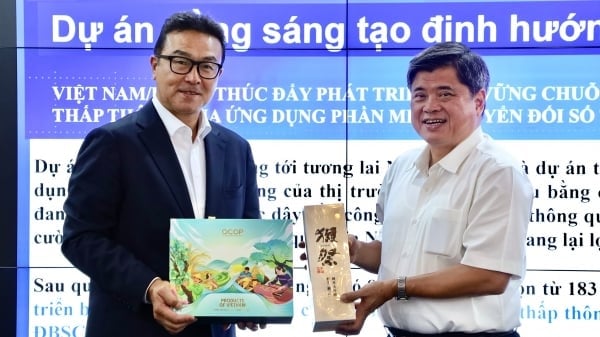
(VAN) On May 23, Deputy Minister of Agriculture and Environment Tran Thanh Nam held a working session with a Japanese delegation on the application of digital technology in agricultural production.
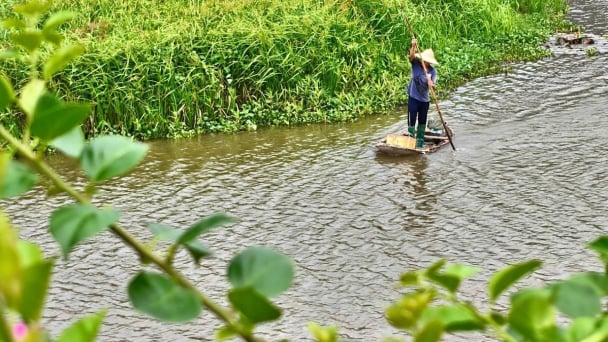
(VAN) In the tranquil wetlands of Van Long, there are quiet souls who guard the forests, nurture the waters, and oversee every bird and troop of langurs as protecting the essence of a living heritage.
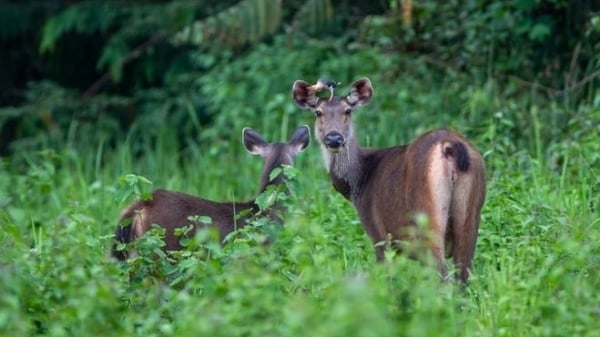
(VAN) WWF, GIZ, IUCN, UNDP call for biodiversity conservation and sustainable development must be regarded as a unity in strategies for a green future.
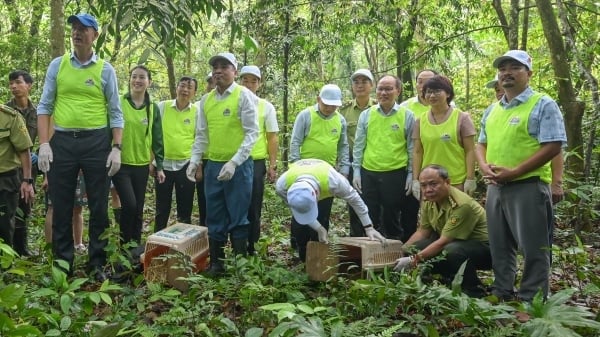
(VAN) On celebration of International Day for Biological Diversity, Deputy Minister Nguyen Quoc Tri called for practical actions to address nature and biodiversity conservation.
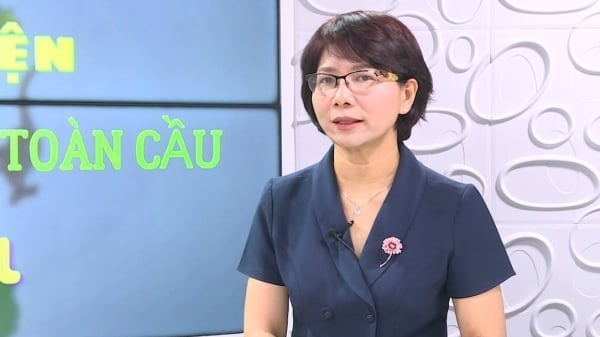
(VAN) Dr. Hoang Thi Thanh Nhan – Deputy Director of the Nature and Biodiversity Conservation Agency – highlighted this on the International Day for Biological Diversity, May 22, 2025.
![Ho Chi Minh city adapts to climate change: [2] Accelerating action](https://t.ex-cdn.com/nongnghiepmoitruong.vn/608w/files/chiqk/2025/05/22/4024-4220-bien-doi-khi-hau-1-100626_766.jpg)
(VAN) Clearly recognizing the challenges posed by climate change, Ho Chi Minh city has swiftly shaped its policies and implemented practical solutions to adapt.
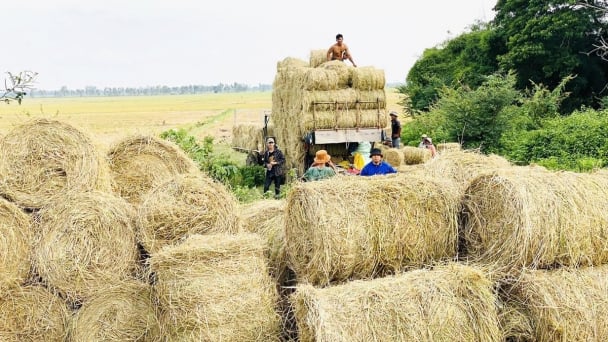
(VAN) Rice straw is no longer just a discarded byproduct, but it is becoming a green resource that helps farmers in the Mekong Delta reduce emissions and promote circular, sustainable agriculture.